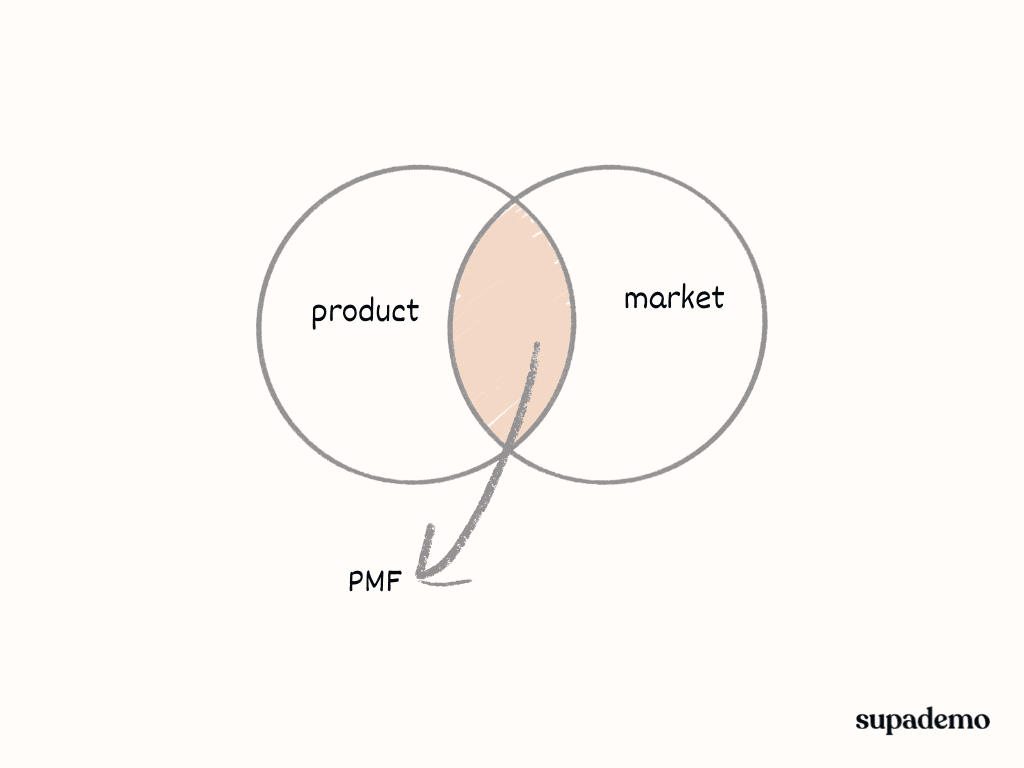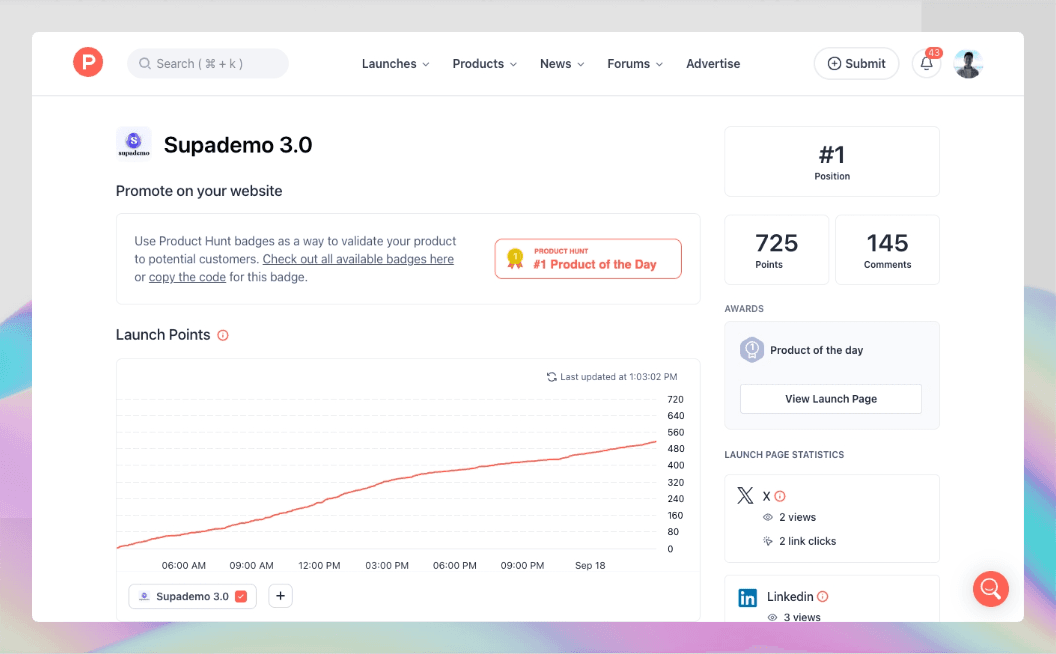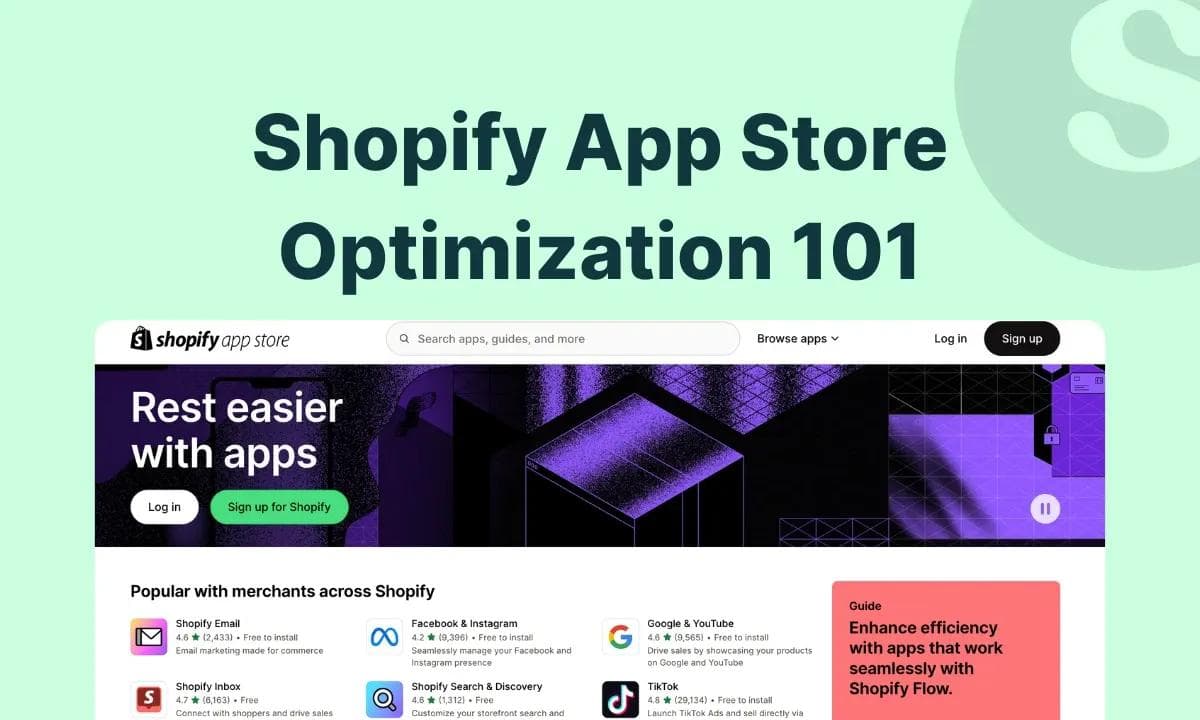
When it comes to building a successful business, achieving product-market fit is crucial. It means that your product or service resonates with your target audience, and there is a strong demand for what you offer. In essence, product-market fit occurs when you have found the sweet spot where your product perfectly meets the needs and desires of your customers.
What is Product-Market Fit?
A common question asked is, what is PMF in business?
🗨️
Product/market fit means being in a good market with a product that can satisfy that market.
-
Marc Andreessen
Product-Market Fit (PMF) is a concept that describes the degree to which a product satisfies a strong market demand. In simpler terms, it means that your product is something that people actually want and are willing to pay for.
Achieving PMF is crucial for the success of any business, as it ensures that your efforts and resources are being directed towards creating something that has a real market demand.
Understanding Product vs. Market
On the product side, quality is defined by how impressive and valuable the product is to its actual users. Key factors that determine product quality include ease of use, feature richness, speed, extensibility, polish, and lack of bugs. A high-quality product should delight its users and provide an exceptional experience.
On the market side, the size of the market is determined by the number and growth rate of potential customers or users for that product. A large and rapidly growing market indicates a strong demand for the product, which is crucial for achieving PMF.

Product-Market Fit: When the Market Pulls for Your Product
In a thriving market with a large pool of potential customers, achieving product-market fit becomes easier. The market demand is so strong that it naturally pulls a viable product out of the startup. As long as the product works and fulfills the basic needs, the market will embrace it, regardless of how great the team is behind it.
When you have a product that meets a real market need, customers will be knocking on your door, eager to get their hands on it.
On the flip side, in a poor market with little to no demand, even the best product and the most talented team will struggle to find success. You could have a groundbreaking product and a killer team, but if the market doesn't exist or is too small, you'll inevitably fail.
Your team will exhaust themselves trying to find customers who simply don't exist for your product, leading to demoralization and eventual disbandment of the startup. This unfortunate situation has been witnessed in industries like videoconferencing, workflow software, and micropayments, where the market demand was insufficient despite having exceptional products.
Why is Product-Market Fit Important?
Achieving product-market fit is a game-changer for any business, and its importance extends far beyond just steady profits. It's a crucial milestone that paves the way for sustainable growth and long-term success.

Here are some key reasons why product-market fit should be a top priority for any business:
1. Tap Into an Existing Customer Base
First and foremost, when you have a product that meets a real market demand, you're essentially tapping into an existing customer base that's ready to buy.
This significantly eases your sales and marketing efforts, allowing you to concentrate on scaling up your operations and expanding your reach. Without product-market fit, attempting to scale too early can lead to wasted resources and potential failure, as you'll be struggling to find customers who truly need your product.
2. Focus on Promising Market Opportunities
Moreover, product-market fit empowers you to focus your efforts on the most promising market opportunities. Once you've identified the right market, you can devote your resources to developing new products or features that will appeal to the same audience, maximizing your chances of success.
When your product perfectly fits the market, your customers become your brand ambassadors. They willingly promote and recommend your product to others, driving organic growth without the need for excessive marketing efforts.
This word-of-mouth marketing is incredibly powerful and can lead to exponential growth and increased market penetration.
Furthermore, the pursuit of product-market fit helps you truly understand your customers and their evolving needs. Gathering customer feedback and consistently analyzing the market allows you to stay informed and adapt your product accordingly, ensuring that it remains relevant and valuable over time.
3. Competitive Advantage
A strong product-market fit gives you a competitive edge in the market.
By delivering a product that resonates with customers and solves their problems better than competitors, you differentiate yourself and create a unique value proposition. This differentiation helps you stand out in a crowded market, attracting more customers and outperforming your competition.
4. Attracting Investors
Investors are always looking for businesses with high growth potential and a proven market demand.
Achieving product-market fit demonstrates that your business has a solid foundation and is poised for success. It gives investors confidence in the viability of your business model and increases the likelihood of securing funding for future growth.
How to Achieve Product-Market Fit
Achieving product-market fit is a crucial step for any business, and it requires a systematic approach. Here are some key steps to help you navigate the process:
1. Define the Target Audience
The first step in achieving product-market fit is to clearly define your target audience.
- Who are the people you're trying to serve?
- What are their demographics and behaviours?
Having a deep understanding of your target audience is essential for tailoring your product to their specific needs.
2. Identify Your Audience's Needs
Once you've defined your target audience, the next step is to identify their specific needs and pain points.
Conduct market research, gather customer feedback, and analyze industry trends to gain insights into the problems your audience is facing and the solutions they're seeking.
3. Test Your Value Proposition
With a clear understanding of your target audience and their needs, you can develop a value proposition that addresses those needs. However, it's crucial to test your value proposition with potential customers to validate its effectiveness.
List your product features and compare them to those of your competitors to determine whether you can outperform them. Find unique ideas or improvements to stand out and offer a better solution.
4. Create a Minimum Viable Product (MVP)
Once you've validated your value proposition, it's time to create a minimum viable product (MVP). An MVP is a basic version of your product that includes only the essential features necessary to address your target audience's core needs.
This approach allows you to quickly test your product in the market, gather feedback, and make necessary improvements before investing heavily in development.
To create your first MVP, you need not use all engineering resources. Using Supademo, you can convert your Figma designs to interactive prototypes in less than five minutes.

Why use interactive demos for your MVP
- Rapid prototyping: Bring ideas to life in a tangible, quicker, interactive format early in the development process easily.
- Product validation and feedback: Get early feedback on new feature desirability, usability, and overall appeal with mock interactive demos.
- A/B testing and experimentation: Create multiple versions of a new feature to gather user feedback and make data-driven decisions on which variations to implement.
Read our detailed guide on how to to reach PMF faster with demo automation
.
5. Product-Market Fit Pyramid

The Product-Market Fit Pyramid, developed by Dan Olsen, offers a valuable framework for understanding and navigating the key components that contribute to successful product-market fit.
- At the base of the pyramid lies the target customer, representing the market you intend to serve with your product.
- This foundational layer is followed by the specific needs and pain points that your target audience is seeking to address.
It's important to note that businesses have limited control over these first two layers, as they represent the market landscape and customer demands that already exist. However, thorough research and analysis of these layers are crucial for informing the subsequent stages of product development.
- Moving up the pyramid, the next layer is the value proposition, which outlines how your product aims to address the identified customer needs. This layer serves as the bridge between understanding the market and crafting a solution that resonates with your target audience.
- The fourth layer encompasses the features and functionality of your product, designed to deliver on the promised value proposition. This layer is where you translate your understanding of customer needs into tangible product features.
- Finally, at the apex of the pyramid lies the user experience, where customers interact with and experience your product firsthand. This layer is pivotal, as it determines whether your product effectively meets the needs and expectations of your target audience.
Can't Great Products Create Massive New Markets?
It's possible, but it's a best-case scenario.
VMware is a recent example of a company whose product was so innovative that it started a whole new market for operating system virtualization, which turned out to be a massive opportunity.
But this is just a best-case scenario. It's probably a one-to-thousand chance most times.
More often, achieving product-market fit involves identifying an existing market need and developing a solution that addresses it well.
How to Measure Product-Market Fit
While product-market fit is not a static state and can evolve over time, there are several key indicators that can help you assess whether you have achieved a strong fit. Here are some essential metrics and methods to consider:
1. Net Promoter Score (NPS)
The Net Promoter Score (NPS) is a widely used metric that measures customer loyalty and satisfaction.
Customers are asked how likely they are to recommend your product or service to others on a scale of 0 to 10. By calculating the NPS, you can assess the overall sentiment and advocacy among your customer base.
A high NPS indicates a strong product-market fit and a high likelihood of organic growth through customer referrals.

2. Open-Ended Customer Surveys
One of the most direct ways to gauge product-market fit is by asking your customers for feedback through surveys. Design surveys that explore their perceptions of your product, whether they consider it a necessity, and if they would be disappointed if it were no longer available.
For example, you could ask questions like, "What type of people would benefit most from using your service/product?"
These survey responses can provide valuable insights into how well your product fits the market and the level of customer satisfaction.
3. Interviews
In addition to surveys, gathering qualitative feedback from your customers is crucial for understanding their needs and experiences.
Conduct interviews or focus groups to delve deeper into their motivations for using your product, the main benefits they derive, and any suggestions for improvement.
For instance, you could ask, "What is the primary reason you use our product?" or "How can we improve our product to better meet your needs?" This qualitative feedback can provide a holistic understanding of how well your product meets the market's demands.
4. Customer Retention Rate + Usuage
A high customer retention rate is a strong indicator of product-market fit. If your customers keep coming back and continue to use your product over an extended period, it suggests that your offering provides ongoing value and consistently meets their needs.
For example, if you have a subscription-based service with a low monthly churn rate (customers cancelling their subscriptions), it's a good sign that your product is a good fit for the market.
5. Market Demand and Growth Rate
Monitoring market demand and your growth rate can provide insights into the overall fit between your product and the market.
Keep track of market trends, competitor activity, and the growth rate of your customer base.
For instance, if you're seeing a rapidly growing customer base and increasing demand for your product category, it's a positive indicator that your product is well-aligned with the needs and desires of your target market. S
Something as simple as seeing more direct competitors coming up is a clear indicator that there's an active market with potential.
Here's a rewritten version avoiding plagiarism and keeping the language simple:
6. LTV:CAC Ratio
Another way to assess if you've achieved product-market fit is by looking at the Lifetime Value (LTV) of your customers compared to the Customer Acquisition Cost (CAC). This ratio can provide valuable insights into the profitability and sustainability of your business model.
First, you need to define what qualifies as an "acquired customer" for your business. For example, it could be anyone who has paid for at least one month of your subscription service.
Next, calculate the LTV of an acquired customer. LTV represents the total revenue you can expect from a customer over the lifetime of their relationship with your business. A simple way to calculate LTV is by multiplying the average purchase value by the average number of purchases and the average customer lifespan.

Then, determine the CAC, which is the cost of acquiring each new customer. This includes expenses like sales and marketing efforts. To calculate CAC, divide the total cost of sales and marketing by the number of new customers acquired during that period.

Finally, divide your LTV by your CAC to find the ratio. A higher ratio means that you're generating more revenue from each customer than it costs to acquire them.

Generally, if your LTV:CAC ratio is 3:1 or higher, it's considered a benchmark for successful growth and a strong indication that you've achieved product-market fit. This ratio suggests that your product is providing enough value to justify the acquisition costs, and your business model is profitable and sustainable.
Misleading Metrics for Evaluating Product-Market Fit
While there are several useful metrics to gauge product-market fit, some metrics can be misleading and should be used with caution. Here are three metrics that are often unreliable indicators of true product-market fit:
1. Registered Users
The number of registered users is a vanity metric that doesn't provide much insight into product-market fit.
Having a large number of registered users doesn't necessarily mean they are actively using or deriving value from your product. It's possible to have a high number of registered users, but if they quickly churn (stop using the product), it suggests a lack of product-market fit.
2. Conversion Rate
Conversion rate, which measures the percentage of visitors who take a desired action (like signing up or making a purchase), can be misleading when assessing product-market fit.
It's relatively easy to attract users to try your product through effective marketing or a compelling landing page. However, if the product itself fails to provide ongoing value, those users are likely to churn, indicating a lack of product-market fit.
3. Free Usage
If your product offers a free version and a paid premium version, high usage of the free version alone is not a reliable indicator of product-market fit.
The true test of product-market fit is whether users are willing to pay for your product. If the paid version has low adoption, it suggests that the perceived value of the premium features is not sufficient to justify the cost, and you may need to reevaluate your pricing strategy or product offering.
While these metrics may initially seem promising, they can paint an incomplete or inaccurate picture of product-market fit. It's crucial to combine multiple data points, such as customer feedback, retention rates, and revenue growth, to gain a comprehensive understanding of how well your product meets the needs of your target market.
3 Real-Life Examples of Product-Market Fit Success
To illustrate the concept of product-market fit in action, let's explore some real-life examples of companies that have achieved success through strong alignment with their target markets.
1. Spotify - Music for Everyone

Spotify recognized the need for a convenient and affordable music streaming platform when illegal music sharing was prevalent. They capitalized on this market opportunity by offering legal access to a vast library of music through their subscription-based service.
By continuously evolving their technology and understanding the preferences of their target audience, Spotify achieved product-market fit.
As of 2022, Spotify boasts 182 million paid subscribers, demonstrating the success derived from recognizing a market need and delivering a product that fits perfectly.
2. Uber - Revolutionizing Ride-Sharing

Uber disrupted the traditional taxi industry by addressing the pain points of customers, such as high prices and inconvenient service.
They introduced a convenient, affordable, and user-friendly ride-sharing platform that allowed customers to request rides at their convenience. Uber's ability to solve a problem and create a need simultaneously propelled them to product-market fit.
Today, Uber serves millions of riders worldwide, with billions of rides recorded annually.
3. Slack - From Video Game to Communication Platform

Slack originally started as an internal communication tool for a video game development team.
However, the founders quickly realized that the market had an unmet need for a robust workplace communication platform. They pivoted their focus, repositioned their product, and created Slack, which has become a leading instant messaging platform for workplace communication.
Slack's quick adaptation and response to market demands exemplify the importance of staying flexible and seizing better opportunities.
A Real-Life Example of Product-Market Fit Failure
Now, lets look at a startup that failed miserably because of no PMF -
Dinnr: Lack of Market Demand Leads to Failure

Dinnr was a startup that aimed to provide a unique "cooking experience" by delivering ingredients and instructions for users to cook special occasion meals at home. The idea was to allow people to enjoy the process of cooking for events like anniversaries and birthdays. However, Dinnr failed to accurately gauge the actual market demand for its offering.
The founders developed the concept based on personal ambitions and interests, without thoroughly validating the market through research and surveys. They overestimated the demand for such a service, failing to recognize that most customers preferred the convenience of either buying ingredients from local stores or ordering ready-made meals.
Ultimately, the lack of market demand for Dinnr's "cooking experience" led to the startup's downfall. Had they conducted comprehensive market research upfront, they may have identified the misalignment between their offering and customer preferences, potentially leading to pivots or adjustments that could have saved the business.
Here's what the founder of Dinnr, Michal Bohanes, shared -
This will be the number one lesson I will never forget and the absolute key to understanding Dinnr’s failure — we were not solving anyone’s problem. I should have found that out in my initial market research, especially in my 1–1 interviews. However, we committed the big mistake of presenting people with the idea and asking them if they liked it and would buy it. And when people said yes, WE thought they meant “launch it and I will buy”. In reality, they meant “I’m not entirely excluding the possibility that one day, when Ocado trucks run out of gas, supermarket doors get blocked by red-hot lava and restaurant waiters will, due to a mysterious leak of radioactive fumes emanating from commercial kitchen equipment, all be zombified and eat patrons’ brains, yes, in that case I might be tempted to purchase a trial product from you. Once. Then I’ll take a risk with the zombies.”
Dinnr's story highlights the importance of validating market demand through research and customer feedback before investing significant resources into a product or service idea.
The Journey Beyond Product-Market Fit
While achieving product-market fit is a significant milestone, it is important to remember that it is not the end of the journey. Markets and customer needs evolve over time, and maintaining a strong fit requires continuous effort and adaptation.
Here are some key considerations as you move forward:
1. Ongoing Customer Engagement
Maintain open lines of communication with your customers and actively seek their feedback. Regularly engage with them through surveys, interviews, and social media interactions. By staying connected to your customers, you can stay attuned to their evolving needs and preferences.
2. Continuous Improvement
Product-market fit is not a one-time achievement but an ongoing process. Continuously strive to improve your product, enhance its features, and address emerging customer needs. Use customer feedback, market research, and industry trends to guide your product development efforts.
3. Scaling and Growth
Once you have achieved product-market fit, it's time to focus on scaling your business. Leverage your existing customer base, word-of-mouth referrals, and marketing strategies to expand your reach and acquire new customers. Ensure that your operations can handle increased demand and maintain the quality of your product or service as you grow.
4. Market Monitoring
Keep a close eye on your market and competitors. Stay informed about industry trends, emerging technologies, and customer preferences. Regularly assess your competition and make strategic adjustments to maintain your competitive advantage.
Wrapping Up!
We hope this guide helped you understand what is PMF in business.
Achieving product-market fit is a critical milestone for any business. It requires a deep understanding of your target audience, their needs, and the competitive landscape.
By aligning your product or service with the market's demands, you can drive organic growth, outperform competitors, and attract investors. Continuously measuring and refining your product-market fit ensures that you stay relevant and successful in an ever-changing market landscape.
Remember, product-market fit is not a destination but an ongoing journey of customer-centric innovation and improvement.
Build better products with Supademo
Validate ideas, gather user insights, and iterate rapidly, early in the product development process.
Hiba Fathima
Hiba Fathima is the first Product Marketer at Supademo. She previously led product marketing at top Indian tech firms and loves turning complex products into clear, compelling stories.





